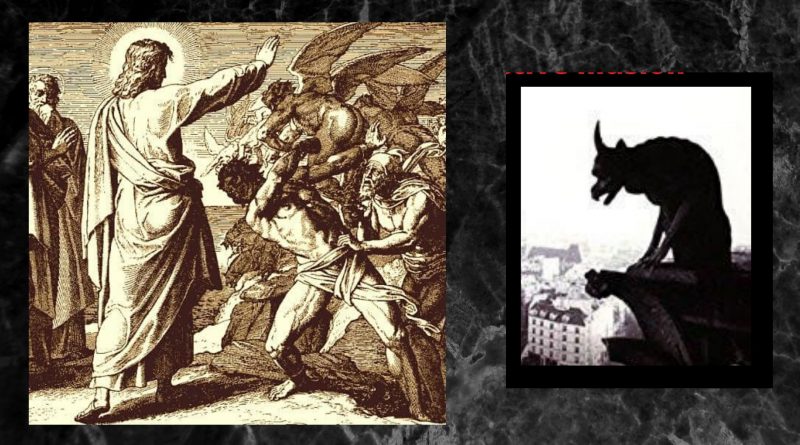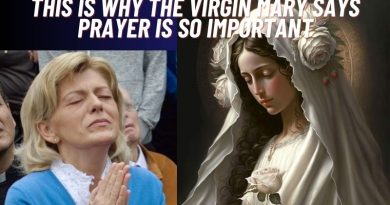DEMONS IN THE BIBLE – (THE FALLEN ANGELS) DIFFERENT TYPES AND HOW THEY ATTACK
DEMONS IN THE BIBLE – (THE FALLEN ANGELS) DIFFERENT TYPES AND HOW THEY ATTACK
What Are Demons?
The Bible provides abundant evidence of the existence of demons. Satan’s evil angels are known in Scripture as demons. We know from certain Scriptures that Satan fell from heaven and other angelic beings (demons) shared in Satan’s fall and became evil (Ezekiel 28:18; Matthew 25:41; Revelation 12:4).

In Jesus Christ’s teachings and ministry He often confronted demons and their activities, i.e., demonic possession of individuals (Matthew 12:22-29, 15:22-28, 25:41; Mark 5:1-16). Christ demonstrated His power over demons and, furthermore, He gave His disciples power to cast out demons (Matthew 10:1). (ANGELS ELECT AND EVIL, C. Fred Dickason, p. 150).
Demons attack in a number of ways. Examples provided in the Bible include:
Physical Illness
Mental Impairment
The Spread of False Doctrine
Spiritual Warfare
Possession
Theories Surrounding the Origin of Demons
There are a number of suggestion origins of demons, with the most logical being that they are fallen angels.
They are spirits of deceased wicked men. However, this cannot be, for the Bible declares the unsaved dead are in Hades and not roaming the earth (Psalm 9:17; Luke 16:23; Revelation 20:13).
They are spirits of a pre-Adamic race. But there is no scriptural support whatsoever for this view. The Bible declares that Adam was the first man (1 Corinthians 15:45).
They are the spirits from the unnatural union between angels and women in Genesis 6. However, this view, like the previous two, is without the slightest Biblical support.
The most logical conclusion is that the word demon is simply another title or name for fallen angels. (THE DOCTRINE OF ANGELS, Dr. H. L. Willmington, pp. 23,24).
Two Greek words are translated similarly in the New Testament but their meanings are slightly different. The word diabolos is translated ‘devil’ and refers to the devil himself. Another word, diamon, is usually translated ‘devils’ in the King James Version but might be better translated ‘demons.’ The Bible makes a very real distinction between a single devil and many demons. Whenever we read of ‘devils’ in the Bible, we are reading about demons.
It appears most likely that demons are fallen angels who rebelled against God in heaven and were cast out of the presence of God. As such, what things are true about the nature of good angels are also true of demons. When it comes to identifying demons, the question that should be asked is “Where do demons come from?” At least four suggestions have been made to help explain the origin of demons.
Spirits of the Dead
One contemporary idea relating to the origins of demons claims they are the spirits of the evil dead. This is the underlying assumption of much of the popular occult literature. It is not a new idea at all, for it was the explanation of some Greek philosophers years before Christ. The early age of this theory does not however make it any more believable. It stands in direct conflict with biblical teaching.
The Bible teaches that the souls of the evil dead go to ‘Hades’ (Luke 16:23). They will remain there until the end of the millennial reign of Christ on this earth. Only then are they brought before God to be judged (Rev. 20:11). Then they are cast into eternal punishment.
Then Death and Hades were thrown into the lake of fire. This is the second death, the lake of fire. Revelation 20:14
Children of Angels
Some have suggested that demons are the result of the union of angels and women as described:
The Nephilim (giants) were on the earth in those days, and also afterward, when the sons of God came in to the daughters of man and they bore children to them. These were the mighty men who were of old, the men of renown. Genesis 6:4
Some suggest that this verse describes sexual relations between angels and women, since the expression ‘sons of God’ is used elsewhere in the Old Testament to identify angels. Even if this interpretation is correct, it is extremely unlikely that such a union produced demons. Some have suggested the ‘giants’ could be an expression of the political or military might of these men. Others believe it could refer to the results of genetic tampering in a pre-Flood society. But there is no scriptural evidence to prove that the result of the union of humans and angels were demons.
Pre-Adamic Spirits
One explanation, called the ‘gap theory,’ presupposes that the world is several million years old. According to this theory, God created a perfect world and society, as recorded in the first verse of the Bible but, for one reason or another, God had to destroy it before the situation as described in Genesis 1:2. This theory allowed for a society which existed for millions of years, thus harmonizing the contemporary views of the age of the world with the Bible account of creation.
The spirits of those who lived before Adam, still inhabiting the earth are the demons, according to those who hold this view. But before we can conclude that demons are the disembodied spirits of a pre-Adamic race, we must first prove the existence of such a race. Once again, most biblical evidence is against such a theory.
Fallen Angels
Most conservative scholars believe that demons are fallen or evil angels. When Jesus described hell, he called it “eternal fire prepared for the devil and his angels” (Matt. 25:41). John described the fall of Satan in a highly symbolic fashion, noting that the devil took a third of the angels in heaven with him.
His tail swept down a third of the stars of heaven and cast them to the earth. And the dragon stood before the woman who was about to give birth, so that when she bore her child he might devour it. Revelation 12:4
This has led some to conclude that Satan was of three angels responsible, with Gabriel and Michael, to other angels. When Satan fell, a third of the angels which he had supervision may have followed him in rebellion against God.
When Israel finally prepared to enter the Promised Land, God instructed Israel regarding their relationship to the occult demonic religions of Canaan.
When you come into the land that the Lord your God is giving you, you shall not learn to follow the abominable practices of those nations. Deuteronomy 18:9
Despite the obvious implication that Christians should not be engaged in occult practices, some church youth gatherings have played around with such things as astrology, Ouija boards, and other games that have some relationship to ‘the spirits.’ One who recognizes biblical authority will seek to rid his life of any occult influences.
Names of Demons in the Bible
In rare instances, the Bible mentions demons by name. These demons had such an impact on the lives of believers that their presence warranted mention by the writers of the scripture.
Molech
Although the scriptures never explicitly refer to Molech as a demon, the worship of Molech was a recurring problem for Israel throughout the Old Testament. The origin of Molech worship is unclear. Scholars believe that Molech worship came to the region of Canaan with the Phoenicians.
You shall not give any of your children to offer them to Molech, and so profane the name of your God: I am the Lord. Leviticus 18:21
Then Solomon built a high place for Chemosh the abomination of Moab, and for Molech the abomination of the Ammonites, on the mountain east of Jerusalem. 1 Kings 11:7
One of the most documented practices of Molech worship was that of human sacrifice. Molech worship reached its peak during the reign of Solomon and would not be abolished until the time of captivity in Babylon.
Legion
Demons in the Bible often congregate together and one example is Legion. When Jesus arrived at the country of the Gerasenes, He encountered a possessed man on the outside of the city in a cemetery.
And when Jesus had stepped out of the boat, immediately there met him out of the tombs a man with an unclean spirit. He lived among the tombs. And no one could bind him anymore, not even with a chain, for he had often been bound with shackles and chains, but he wrenched the chains apart, and he broke the shackles in pieces. No one had the strength to subdue him. Night and day among the tombs and on the mountains he was always crying out and cutting himself with stones. And when he saw Jesus from afar, he ran and fell down before him. And crying out with a loud voice, he said, “What have you to do with me, Jesus, Son of the Most High God? I adjure you by God, do not torment me.” For he was saying to him, “Come out of the man, you unclean spirit!” And Jesus asked him, “What is your name?” He replied, “My name is Legion, for we are many.” And he begged him earnestly not to send them out of the country. Mark 5:2-10
The Lanterne of Light’s classification of demons
In 1409-1410 The Lanterne of Light (an anonymous English Lollard tract often attributed to John Wycliffe)[4] provided a classification system based on the Seven Deadly Sins, establishing that each one of the mentioned demons tempted people by means of one of those sins. This list was later used in the works of John Taylor, the Water Poet.[7] (Terms in brackets are those found in the text):
1. Lucifer: Pride
2. Beelzebub: Envy (envious)
3. Satan (Sathanas): Wrath (wraþþe)
4. Abaddon: Sloth (slowȝ)
5. Mammon: Greed (auarouse)
6. Belphegor: Gluttony (glotouns)
7. Asmodeus: Lust (leccherouse)
Spina’s classification of demons
Alphonso de Spina, in 1467, prepared a classification of demons based on several criteria:
Demons of fate
Incubi and succubi
Wandering groups or armies of demons can include multiple regions in hell
Familiars
Drudes
Cambions and other demons that are born from the union of a demon with a human being.
Liar and mischievous demons
Demons that attack the saints
Demons that try to induce old women to attend Witches’ Sabbaths
This classification is somewhat capricious and it is difficult to find a criterion for it. It seems that Spina was inspired by several legends and stories. The drudes belong to German folklore. Familiars, goblins, and other mischievous demons belong to the folklore of most European countries.
The belief in incubi and succubi (and their ability to procreate) seem to have inspired the seventh category, but it could also have been inspired in the Talmudic legend of demons having sexual intercourse with mortal women (see also Mastema).
The visions of tempting demons that some early (and not so early) saints had, perhaps inspired the ninth category (e.g. the visions of Anthony the Great).
The idea of old women attending Sabbaths was common during the European Middle Age and Renaissance, and Spina mentioned it before the Malleus Maleficarum.
First hierarchy
The first hierarchy includes angels that were Seraphim, Cherubim and Thrones.
Beelzebub was a prince of the Seraphim, just below Lucifer. Beelzebub, along with Lucifer and Leviathan, were the first three angels to fall. He tempts men with pride and is opposed by St. Francis of Assisi.
Leviathan was also a prince of the Seraphim who tempts people to give into heresy, and is opposed by St. Peter.
Asmodeus was also a prince of the Seraphim, burning with desire to tempt men into wantonness. He is opposed by St. John the Baptist.
Berith was a prince of the Cherubim. He tempts men to commit homicide, and to be quarrelsome, contentious, and blasphemous. He is opposed by St. Barnabas.
Astaroth was a prince of Thrones, who tempts men to be lazy and is opposed by St. Bartholomew.
Verrine was also a prince of Thrones, just below Astaroth. He tempts men with impatience and is opposed by St. Dominic.
Gressil was the third prince of Thrones, who tempts men with impurity and is opposed by St. Bernard.
Soneillon was the fourth prince of Thrones, who tempts men to hate and is opposed by St. Stephen.
Second hierarchy
The second hierarchy includes Powers, Dominions, and Virtues.
Carreau was a prince of Powers. He tempts men with hardness of heart and is opposed by St. Vincent and Vincent Ferrer.
Carnivale was also a prince of Powers. He tempts men to obscenity and shamelessness, and is opposed by John the Evangelist.
Oeillet was a prince of Dominions. He tempts men to break the vow of poverty and is opposed by St. Martin.
Rosier was the second in the order of Dominions. He tempts men against sexual purity and is opposed by St. Basil.
Belias was the prince of Virtues. He tempts men with arrogance and women to be vain, raise wonton children, and gossip during mass. He is opposed by St. Francis de Paul.
Third hierarchy
The third hierarchy includes Principalities, Archangels, and Angels.
Verrier was the prince of Principalities. He tempts men against the vow of obedience and is opposed by St. Bernard.
Olivier was the prince of the Archangels. He tempts men with cruelty and mercilessness toward the poor and is opposed by St. Lawrence.
Luvart was prince of Angels. At the time of Michaelis’s writing, Luvart was believed to be in the body of a Sister Madeleine.[15]
Many of the names and ranks of these demons appear in the Sabbath litanies of witches, according with Jules Garinet’s Histoire de la magie en France, and Collin De Plancy’s Dictionnaire Infernal.
* READ MORE CATHOLIC DEMONOLOGY









